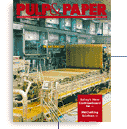|

Paul W. Lail, CFPIMis manager of logistics for coated and supercalendered papers at Champion International Corp.
|

Capacity Restraint: What does it mean for IT?
The news that U.S. paper and paperboard capacity actually declined in 1999 (Pulp & Paper, January 2000, pg. 36) seemed like the passing of a milestone. Together with continued forecasts of nearly flat capacity growth in the years ahead, the days of building new mills and machines seem a memory.
After pondering this news, my thoughts turned to how this is likely to impact those working in information technology (IT) throughout the industry. Over the next several years, it seems that the view of IT will increasingly change from a provider of basic transaction systems capabilities to a provider of the information that allows better, smarter utilization of the capacity that is in place.
When paper companies were building and upgrading mills and machines, focus was placed on managing the capital projects and on plans to sell, manage, track, and distribute the new production. For IT, this often meant new transaction systems or major modifications to existing systems. Many IT departments have had a “major projects” focus over the last 20 years where the basic transaction systems governing administration, order fulfillment, and maintenance were put into place. While some smaller mills are still in need of the basic transaction systems, most larger mills and companies have them in place.
With less emphasis on capacity expansion, improvement rests with more effective utilization of the capacity that is in place. How capital-intensive businesses, such as pulp and paper, manage their resources is central to their profitability. Furthermore, the information provided to decision makers will determine whether capacity is managed in a way that complements or detracts from a company’s profitability. So, what are the areas in which IT can influence how effectively capacity is managed?
SALES AND MARKETING. One of the first areas in which IT can influence capacity management is sales and marketing. Does your company know which products, grades, markets, and customers are most and least profitable? Can the profitability of an order be determined before it is taken? Is the estimated cost to fulfill an order taken into account in the pricing decision?
IT personnel and the systems they support will increasingly be asked to help answer these questions. As companies move to real-time pricing and order placement over the internet, where a customer interacts with the data provided by a supplier instead of a company representative, information will determine what customers and orders are won or lost.
PLANNING AND SCHEDULING. Decision support in the planning and scheduling area is another area where IT will play an increasingly important role. Planning involves the combination of information from customers (forecasts, orders) with the information on a company’s ability to deliver (manufacturing capability, inventory).
For many paper companies, planning and scheduling decisions are made on “gut feel,” and the planner has little to go on in terms of profit and service impact. Better information can help planners weigh various tradeoffs and options before decisions are made.
PRODUCT COST INFORMATION. Accurate product cost information is key in supporting decisions in the sales, marketing, and scheduling areas, as well as for management of the manufacturing process itself. Without good information on costs, sub-optimal or even poor decisions on the management of capacity will be made.
Cost information is a foundation and a key building block in the capacity management exercise. Standard, average, or historical cost measures may have been sufficient in the past, but they will not suffice in the years ahead. Activity-based costing, and understanding what “drives” and influences manufacturing and distribution costs, will become increasingly important. Many areas depend on the analysis of cost information to guide their activities, and IT will play an even larger role in providing this information in meaningful ways.
NEW FOCUS FOR IT. In the past, IT departments were filled with systems analysts and programmers. Going forward, maybe titles like information analyst and data architect are more appropriate. The focus on tighter management of existing capacity will shape and redefine the work done in IT departments. This is already evident in the work being done on data warehousing and decision-support systems.
Increasingly, IT departments will be asked to understand, help analyze, and present the information collected by systems. This information will become more and more critical to effective management of capacity, and it will shape decisions that determine the relative success of companies in the paper industry of the future.

|





